|
|
|
Sort Order |
|
|
|
Items / Page
|
|
|
|
|
|
|
| Srl | Item |
| 1 |
ID:
124113
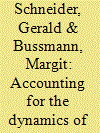

|
|
|
|
|
| Publication |
2013.
|
| Summary/Abstract |
This article presents the Konstanz One-Sided Violence Event Dataset (KOSVED) which allows researchers to study the dynamics of civilian abuse in 17 civil wars. The dataset provides, based on a multitude of sources, detailed information on the number of civilians killed or harmed by government or rebel troops. Where information is available, KOSVED also documents the dates of these events as well as the identities of the perpetrators and the means used in terrorizing the civilian population. The authors argue that the content analysis of news reports offers relatively accurate figures on those events that the perpetrators cannot hide from the public and that receive prominent media attention. Presumably, such information motivates potential short-term retaliatory acts by the group that has been the target of one-sided violence. The analysis suggests that, over the course of a conflict, almost all actors attack unarmed citizens, although to radically different degrees and relying on different means.
|
|
|
|
|
|
|
|
|
|
|
|
|
|
|
|
| 2 |
ID:
098413


|
|
|
|
|
| Publication |
2010.
|
| Summary/Abstract |
The authors analyse newly collected time-series data measuring the dimensions of violent political conflict in Egypt. Attention is focused on the interaction between politically motivated attacks by Islamists and the counter-insurgency measures used by the Egyptian government. Both insurgency and counter-insurgency are multidimensional. Insurgency includes attacks on tourists, on Egyptian civilians and on security forces. Counter-insurgency includes arrests and attacks on militants. To some extent, the dynamics of insurgency and counter-insurgency can be described by two distinct cycles of violence: one related to highly politicized activities on both sides, and another related to less explicitly political activities. However, the two cycles are inter-related, leading to complex and asymmetric dynamics in the relationships between the different dimensions of the conflict. The authors find that the combination of political repression and military counter-insurgency measures employed by the Egyptian government has the potential to exacerbate rather than reduce political violence. On the other hand, the overall level of conflict intensity in Egypt can be mitigated by food subsidies. Finally, the existence of significant spillovers from upsurges in the Israeli-Palestinian conflict shows the regional importance of reaching a Middle East peace agreement.
|
|
|
|
|
|
|
|
|
|
|
|
|
|
|
|
| 3 |
ID:
111084


|
|
|
|
|
| Publication |
2012.
|
| Summary/Abstract |
How do policy actions affect the dynamics of deregulated electricity prices? We investigate this issue in the context of the Italian Power Exchange (IPEX), using data on the daily average day-ahead price (PUN) between April 2004 and December 2008.
Estimates of baseline time series models (SARMAX and SARMAX-EGARCH) and their forecasting performances suggest that the trend in natural gas prices, market power indicators, deterministic weekly patterns, perceived temperatures, persistence in conditional volatility, and the inverse leverage effect are essential features of the PUN dynamics. We then augment the best-performing models with dummies that account for changes in the market architecture, such as the introduction of contracts for differences (CfDs) to support renewables, trading of white certificates for energy efficiency, and the demand-side liberalization. The findings show that changes in the market architecture affected both the PUN level and its volatility. Specifically, wholesale electricity prices and volatility appear to have decreased upon the introduction of CfDs, only to be pushed upwards following the start of white certificates' trading and retail liberalization. Moreover, after controlling for reforms the inverse leverage effect vanishes, and the persistence in volatility is lower than in the baseline estimates.
|
|
|
|
|
|
|
|
|
|
|
|
|
|
|
|
| 4 |
ID:
147613


|
|
|
|
|
| Summary/Abstract |
There are to date no official Chinese statistics relating to capital stocks. This lacking data hinders econometric studies of growth in this country. Series of such stocks are proposed in the literature, but most available empirical work on this topic suffers multiple deficiencies. The purpose of this article is to build the most reliable and longest possible statistical series of capital stocks for China. Our initial capital stocks are calculated on the basis of an output-capital ratio which is less approximate (and lower) than those generally provided. Our investment flows are consistent with the perimeters of the initial stocks. Our investment price indices are strictly tailored to the content of these stocks, and the unit root tests show that all the indices are non-stationary and cointegrated to the order of 2. This means they cannot be substitutes, as supposed in many other studies. Our depreciation rates are estimated by type of capital, under assumptions consistent with age-efficiency and retirement. Investment shares are used to approximate an overall capital structure and to calculate a total depreciation rate. Built from 1952 to 2014, our original series are available to econometricians seeking to conduct new empirical studies on China, over the long run.
|
|
|
|
|
|
|
|
|
|
|
|
|
|
|
|
| 5 |
ID:
116060
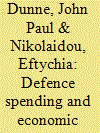

|
|
|
|
|
| Publication |
2012.
|
| Summary/Abstract |
Over the last 30?years, there has been an impressive amount of empirical work on the defence-growth nexus, using different methodologies, models and econometric techniques and focusing on individual case studies, cross-country studies or panel data studies. Despite the number and the variety of studies, the evidence on the defence-growth relationship is still far from conclusive. Rather surprisingly, very limited work has been published in the relevant literature for the European Union despite the continuous discussions for a Common European Defence Policy that would require an assessment of the economic effects of defence in this region. To fill in the gap in the literature, this paper employs an augmented Solow-Swan model and estimates it both with panel and time series methods to provide empirical evidence on the economic effects of defence spending in the EU15 over the period 1961-2007. Overall, evidence derived from both panel and time series methods is consistent and suggests that military burden does not promote economic growth in this region.
|
|
|
|
|
|
|
|
|
|
|
|
|
|
|
|
| 6 |
ID:
117634
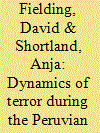

|
|
|
|
|
| Publication |
2012.
|
| Summary/Abstract |
The international community has a declared intention to protect civilians from deliberate violence in civil conflicts. The optimal type of foreign intervention and its optimal timing are likely to depend on the combat strategies of the belligerents. Weak belligerents unable to provide economic incentives and security guarantees to civilians often follow a strategy of intimidation and terror. In this case, foreign financial support for one side could affect the strategies of both sides in several different ways, and the interaction between the two sides' strategies could magnify the resulting impact on civilian casualties. Using a new monthly time-series dataset, we explore the factors associated with variations in the intensity of civilian abuse by participants in the guerrilla war in Peru during the 1980s and 1990s. We show that an increase in civilian abuse by one side was strongly associated with subsequent increases in abuse by the other. In this type of war, foreign intervention could substantially reduce the impact on civilians of a sudden rise in conflict intensity, by moderating the resulting 'cycle of violence'. In practice, foreign interventions had a mixed record in Peru: financial support for the Peruvian military raised the level of violence against civilians, but counter-narcotics aid and development aid reduced it. These effects are consistent with a model in which different types of intervention have different effects on belligerents' resource capacity and on the opportunity cost of fighting.
|
|
|
|
|
|
|
|
|
|
|
|
|
|
|
|
| 7 |
ID:
079648
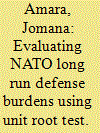

|
|
|
|
|
| Publication |
2007.
|
| Summary/Abstract |
This study evaluates NATO long run defense burdens by analyzing the time-series properties of burden measures, namely growth of defense spending, defense share in national output, defense share in government spending, defense spending per capita, and defense share in total NATO spending for the time period 1949-2002. The study also compares the effect of using government Purchasing Power Parity conversion factors and Market Exchange Rates for defense share in total NATO expenditure conversions and the implications of NATO expansion in light of the defense burden measures of the newer NATO members.
|
|
|
|
|
|
|
|
|
|
|
|
|
|
|
|
| 8 |
ID:
150820
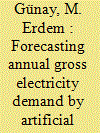

|
|
|
|
|
| Summary/Abstract |
In this work, the annual gross electricity demand of Turkey was modeled by multiple linear regression and artificial neural networks as a function population, gross domestic product per capita, inflation percentage, unemployment percentage, average summer temperature and average winter temperature. Among these, the unemployment percentage and the average winter temperature were found to be insignificant to determine the demand for the years between 1975 and 2013. Next, the future values of the statistically significant variables were predicted by time series ANN models, and these were simulated in a multilayer perceptron ANN model to forecast the future annual electricity demand. The results were validated with a very high accuracy for the years that the electricity demand was known (2007–2013), and they were also superior to the official predictions (done by Ministry of Energy and Natural Resources of Turkey). The model was then used to forecast the annual gross electricity demand for the future years, and it was found that, the demand will be doubled reaching about 460 TW h in the year 2028. Finally, it was concluded that the approach applied in this work can easily be implemented for other countries to make accurate predictions for the future.
|
|
|
|
|
|
|
|
|
|
|
|
|
|
|
|
| 9 |
ID:
144785
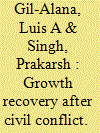

|
|
|
|
|
| Summary/Abstract |
Using recent econometric techniques based on fractional integration, we find that developing countries recover their economic growth faster than developed countries in response to a shock. Following this methodology, we find that longer civil conflicts are associated with a faster recovery process. We further investigate this issue by exploring correlations with components of GDP, military spending, institutions and aid and find heterogeneous effects of these channels by duration of conflict. Higher government spending is correlated with faster recoveries post longer conflicts, and higher consumption spending is linked to faster recoveries following shorter conflicts. Military spending appears to be driving the government expenditure that makes countries recover from longer conflicts. More democratic institutions are associated with faster recoveries post short wars but slower recoveries following long wars.
|
|
|
|
|
|
|
|
|
|
|
|
|
|
|
|
| 10 |
ID:
180044
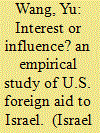

|
|
|
|
|
| Summary/Abstract |
Research on the determinants of U.S. foreign aid to Israel is commonly motivated by two contesting theoretical paradigms. Pioneered by Organski, the self-interest paradigm conceptualises aid as a mutually beneficial deal that helps the U.S. to advance its interest in the Middle East. The influence paradigm, best showcased by Mearsheimer and Waltz, views U.S. aid to Israel as a corollary of the overwhelming influence of pro-Israel interest groups on U.S. foreign policy decision-making. This article attempts to shed new light on the debate by using systematic data analysis. The results show consistent evidence in support of the self-interest paradigm.
|
|
|
|
|
|
|
|
|
|
|
|
|
|
|
|
| 11 |
ID:
145703


|
|
|
|
|
| Summary/Abstract |
Previous models of international conflict have suffered two shortfalls. They tend not to embody dynamic changes, focusing rather on static slices of behavior over time across a single relational dimension. These models have also been empirically evaluated in ways that assumed the independence of each country, when in reality they are searching for the interdependence among all countries. A number of approaches are available now for analyzing relational data such as international conflict in a network context and a number of these can even handle longitudinal relational data, but none are developed to the point of exploring how networks can coevolve over time. We illustrate a solution to the limitations of existing approaches and apply this novel, dynamic, network based approach to study the dependencies among the ebb and flow of daily international interactions using a newly developed, and openly available, database of events among nations.
|
|
|
|
|
|
|
|
|
|
|
|
|
|
|
|
| 12 |
ID:
105790


|
|
|
|
|
| Publication |
2011.
|
| Summary/Abstract |
In this paper, the price elasticity of electricity demand, representing the sensitivity of customer demand to the price of electricity, has been estimated for South Australia. We first undertake a review of the scholarly literature regarding electricity price elasticity for different regions and systems. Then we perform an empirical evaluation of the historic South Australian price elasticity, focussing on the relationship between price and demand quantiles at each half-hour of the day.
This work attempts to determine whether there is any variation in price sensitivity with the time of day or quantile, and to estimate the form of any relationships that might exist in South Australia.
|
|
|
|
|
|
|
|
|
|
|
|
|
|
|
|
| 13 |
ID:
151113
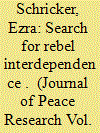

|
|
|
|
|
| Summary/Abstract |
The existing conflict literature tends to treat interdependence between rebel groups as a binary category: either groups are allied or unallied, fragmented or unified, interdependent or independent. Yet much of our qualitative knowledge suggests that interdependence is better understood as a matter of degree where certain groups exert a disproportionate influence over their counterparts. The challenge is how to identify the degree of interdependence in practice. As a solution, I conceptualize interdependence as a property of a system of interactions between rebel groups and government forces within and across borders. My approach is to model the entire system of interactions in order to test hypotheses related to the directionality of influence and the potential for military coordination between groups. I demonstrate the utility of this approach by examining the relationship between Pakistan and the two major factions which make up the Taliban organization – the Afghan and Pakistani Taliban. I analyze the triangular system with a vector autoregressive model and monthly time series data on violent actions initiated by each group from January 2008 to February 2013. The substantive findings support much of the received wisdom concerning Pakistan’s disparate relationship to both groups, which is characterized by antagonism with the Pakistani Taliban and collusion with the Afghan Taliban. The results also suggest that the claims of interdependence between the two Taliban groups have been overstated.
|
|
|
|
|
|
|
|
|
|
|
|
|
|
|
|
| 14 |
ID:
171018
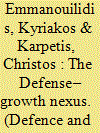

|
|
|
|
|
| Summary/Abstract |
A great part of the defense literature is focused on the interaction between military spending and economic activity. To investigate this interrelationship, researchers have applied a wide variety of methodologies with totally different assumptions and statistical properties. Until today, however, no detailed examination of the sensitivity of empirical results to the various statistical methods has been provided in the literature. The present paper attempts to fill this gap by providing, firstly, a review of the majority of the time series methodologies used in the defense–growth literature and, secondly, an econometric application using data of the U.S. economy over the period 1961–2015 in order to establish empirically the association between econometric procedures and empirical results. The empirical findings of the conducted analysis suggest that statistical methods can indeed become a significant source of variation in the investigation of the defense–growth nexus.
|
|
|
|
|
|
|
|
|
|
|
|
|
|
|
|
|
|
|
|
|